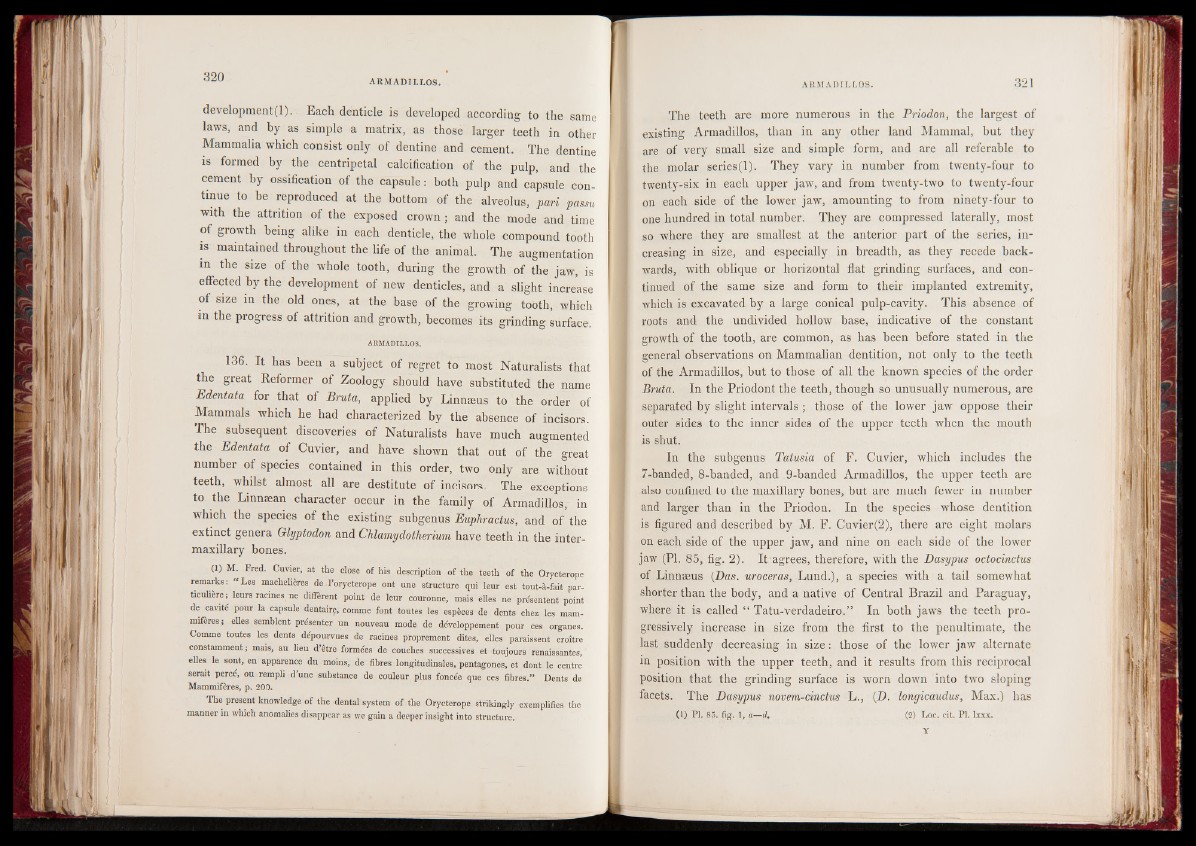
development(1). Each denticle is developed according to the same
laws, and by as simple a matrix, as those larger teeth in other
Mammalia which consist only of dentine and cement. The dentine
is formed by the centripetal calcification of the pulp, and the
cement by ossification of the capsule : both pulp and capsule continue
to be reproduced at the bottom of the alveolus, pari passu
with the attrition of the exposed crown ; and the mode and time
of growth being alike in each denticle, the whole compound tooth
is maintained throughout the life of the animal. The augmentation
in the size of the whole tooth, during the growth of the jaw, is
effected by the development of new denticles, and a slight increase
of size in the old ones, at the base of the growing tooth, which
in the progress of attrition and growth, becomes its grinding surface.
ARMADILLOS.
136. It has been a subject of regret to most Naturalists that
the great Reformer of Zoology should have substituted the name
Edentata for that of Bruta, applied by Linnæus to the order of
Mammals which he had characterized by the absence of incisors.
The subsequent discoveries of Naturalists have much augmented
the Edentata of Cuvier, and have shown that out of the great
number of species contained in this order, two only are without
teeth, whilst almost all are destitute of incisors. The exceptions
to the Linnæan character occur in the family of Armadillos, in
which the species of the existing subgenus Euphractus, and of the
extinct genera Glyptodon and Chlamydotherium have teeth in the intermaxillary
bones.
(1) M. Fred. Cuvier, at the close of his description of the teeth of the Orycterope
remarks : " Les machelières de J ’orycterope ont une structure qui leur est tout-à-fait particulière
; leurs racines ne diffèrent point de leur couronne, mais elles ne présentent point
de cavité pour la capsule dentairç, comme font toutes les espèces de dents chez les mammifères;
elles semblent présenter un nouveau mode de développement pour ces organes.
Comme toutes les dents dépourvues de racines proprement dites, elles paraissent croître
constamment ; mais, au lieu d’être formées de couches successives et toujours renaissantes,
elles le sont, en apparence du moins, de fibres longitudinales, pentagones, et dont le centre
serait percé, ou rempli d’une substance de couleur plus foncée que ces fibres.” Dents de
Mammifères, p. 200.
The present knowledge of the dental system of the Orycterope strikingly exemplifies the
manner in which anomalies disappear as we gain a deeper insight into structure.
The teeth are more numerous in the Priodon, the largest of
existing Armadillos, than in any other land Mammal, but they
are of very small size and simple form, and are all referable to
the molar series(l). They vary in number from twenty-four to
twenty-six in each upper jaw, and from twenty-two to twenty-four
on each side of the lower jaw, amounting to from ninety-four to
one hundred in total number. They are compressed laterally, most
so where they are smallest at the anterior part of the series, increasing
in size, and especially in breadth, as they recede backwards,
with oblique or horizontal flat grinding surfaces, and continued
of the same size and form to their implanted extremity,
which is excavated by a large conical pulp-cavity. This absence of
roots and the undivided hollow base, indicative of the constant
growth of the tooth, are common, as has been before stated in the
general observations on Mammalian dentition, not only to the teeth
of the Armadillos, but to those of all the known species of the order
Bruta. In the Priodont the teeth, though so unusually numerous, are
separated by slight intervals ; those of the lower jaw oppose their
outer sides to the inner sides of the upper teeth when the mouth
is shut.
In the subgenus Tatusia of F. Cuvier, which includes the
7~banded, 8-banded, and 9-banded Armadillos, the upper teeth are
also confined to the maxillary bones, but are much fewer in number
and larger than in the Priodon. In the species whose dentition
is figured and described by M. F. Cuvier(2), there are eight molars
on each side of the upper jaw, and nine on each side of the lower
jaw (PL 85, fig. 2). It agrees, therefore, with the Dasypus octocinctus
of Linnaeus {Das. uroceras, Lund.), a species with a tail somewhat
shorter than the body, and a native of Central Brazil and Paraguay,
where it is called “ Tatu-verdadeiro.” In both jaws the teeth progressively
increase in size from the first to the penultimate, the
last suddenly decreasing in size: those of the lower jaw alternate
in position with the upper teeth, and it results from this reciprocal
position that the grinding surface is worn down into two sloping
facets. The Dasypus novem-cinctus L., (D. longicaudus, Max.) has
(1) PI. 85. fig. 1, a— (2) Loc. cit. PI. lxxx.